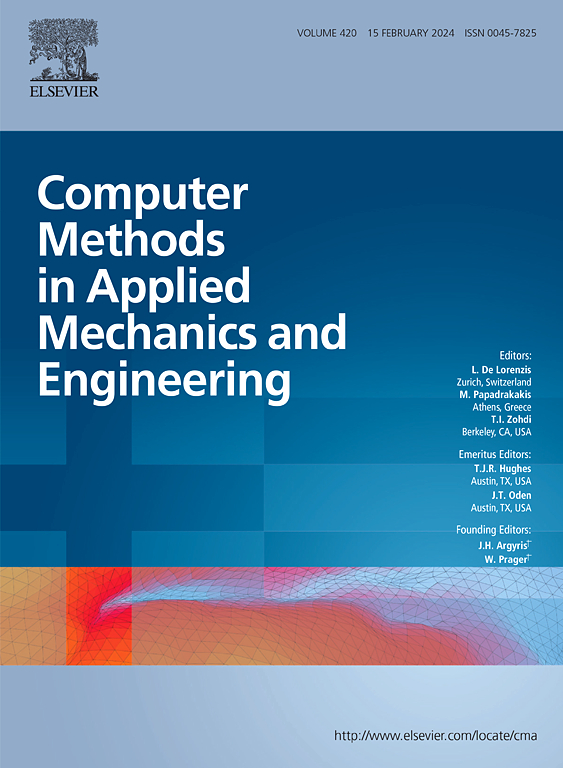Projection-based model order reduction of embedded boundary models for CFD and nonlinear FSI
IF 6.9
1区 工程技术
Q1 ENGINEERING, MULTIDISCIPLINARY
Computer Methods in Applied Mechanics and Engineering
Pub Date : 2025-03-16
DOI:10.1016/j.cma.2025.117920
引用次数: 0
Abstract
Embedded boundary methods (EBMs) for Computational Fluid Dynamics (CFD) and nonlinear fluid–structure interaction (FSI) – also known as immersed boundary methods, Cartesian methods, or fictitious domain methods – are the most robust methods for the solution of flow problems past obstacles that undergo large relative motions, significant deformations, large shape modifications, and/or surface topology changes. They can also introduce a high degree of automation in the task of grid generation and significant flexibility in the gridding of complex geometries. However, just like in the case of their counterpart body-fitted methods, their application to parametric flow computations at high Reynolds numbers remains today impractical in most engineering environments. For body-fitted CFD, the state of the art of projection-based model order reduction (PMOR) has significantly advanced during the last decade and demonstrated a remarkable success at reducing the dimensionality and wall-clock time of high Reynolds number models, while maintaining a desirable level of accuracy. For non-body-fitted CFD however, PMOR is still in its infancy, primarily because EBMs dynamically partition the computational fluid domain into real and ghost subdomains, which complicates the collection of solution snapshots and their compression into a reduced-order basis. In an attempt to fill this gap, this paper presents a robust computational framework for PMOR in the context of high Reynolds number flows and in the EBM setting of CFD/FSI (PMOR-EBM). The framework incorporates a hyperreduction approach based on the energy-conserving sampling and weighting (ECSW) method to accelerate the evaluation of the repeated projections arising in nonlinear implicit computations; and a piecewise-affine approach for constructing a nonlinear low-dimensional approximation of the solution to mitigate the Kolmogorov -width barrier to the reducibility of transport models. The paper also assesses the performance of the proposed computational framework PMOR-EBM for two unsteady turbulent flow problems whose predictions necessitate or benefit from the application of an EBM; and two shape-parametric steady-state studies of the academic type but of relevance to design analysis and optimization.
为 CFD 和非线性 FSI 减少嵌入式边界模型的投影模型阶次
用于计算流体动力学(CFD)和非线性流固相互作用(FSI)的嵌入式边界方法(EBMs),也称为浸入边界方法、笛卡尔方法或虚拟域方法,是解决经过较大相对运动、显著变形、大形状修改和/或表面拓扑变化的障碍物的流动问题的最稳健的方法。它们还可以在网格生成任务中引入高度的自动化,并在复杂几何图形的网格划分中引入显著的灵活性。然而,就像它们的对应体拟合方法一样,它们在高雷诺数下的参数流动计算中的应用在大多数工程环境中仍然是不切实际的。对于贴合体CFD,基于投影的模型降阶(PMOR)技术在过去十年中取得了显著进展,在降低高雷诺数模型的维数和挂钟时间方面取得了显著成功,同时保持了理想的精度水平。然而,对于非体贴合CFD, PMOR仍处于起步阶段,主要是因为EBMs动态地将计算流体域划分为真实子域和虚拟子域,这使得解决方案快照的收集和压缩变得复杂。为了填补这一空白,本文提出了一个在高雷诺数流动和CFD/FSI的EBM设置(PMOR-EBM)下的强健的PMOR计算框架。该框架采用了基于节能采样和加权(ECSW)方法的超约化方法来加速非线性隐式计算中出现的重复投影的评估;以及用于构建解的非线性低维近似的片段仿射方法,以减轻传输模型可约性的Kolmogorov n-width势垒。本文还评估了所提出的计算框架PMOR-EBM对两个非定常湍流问题的性能,这两个问题的预测需要或受益于EBM的应用;以及两个与设计分析和优化相关的学术性形状参数稳态研究。
本文章由计算机程序翻译,如有差异,请以英文原文为准。
求助全文
约1分钟内获得全文
求助全文
来源期刊
CiteScore
12.70
自引率
15.30%
发文量
719
审稿时长
44 days
期刊介绍:
Computer Methods in Applied Mechanics and Engineering stands as a cornerstone in the realm of computational science and engineering. With a history spanning over five decades, the journal has been a key platform for disseminating papers on advanced mathematical modeling and numerical solutions. Interdisciplinary in nature, these contributions encompass mechanics, mathematics, computer science, and various scientific disciplines. The journal welcomes a broad range of computational methods addressing the simulation, analysis, and design of complex physical problems, making it a vital resource for researchers in the field.

 求助内容:
求助内容: 应助结果提醒方式:
应助结果提醒方式:


